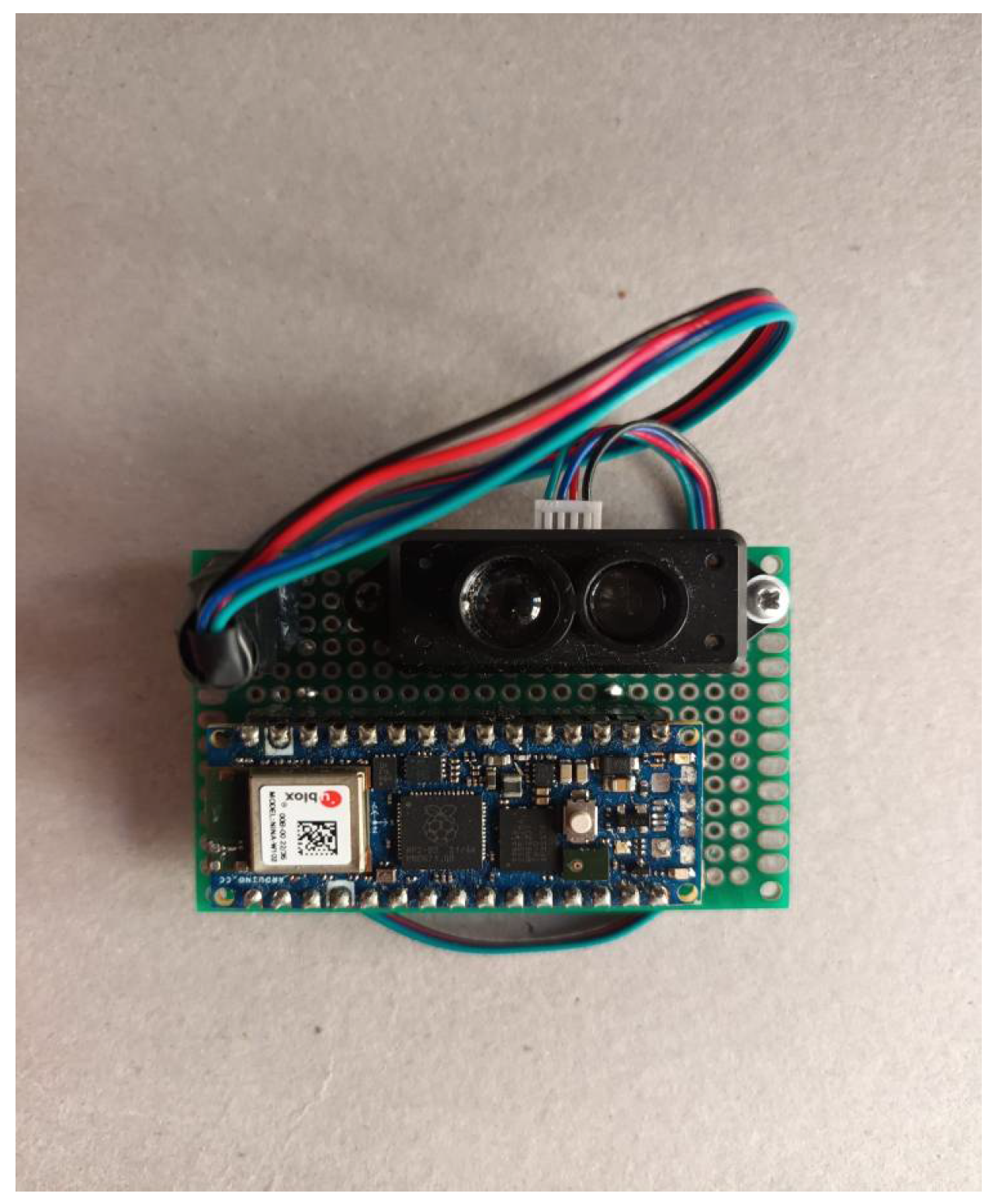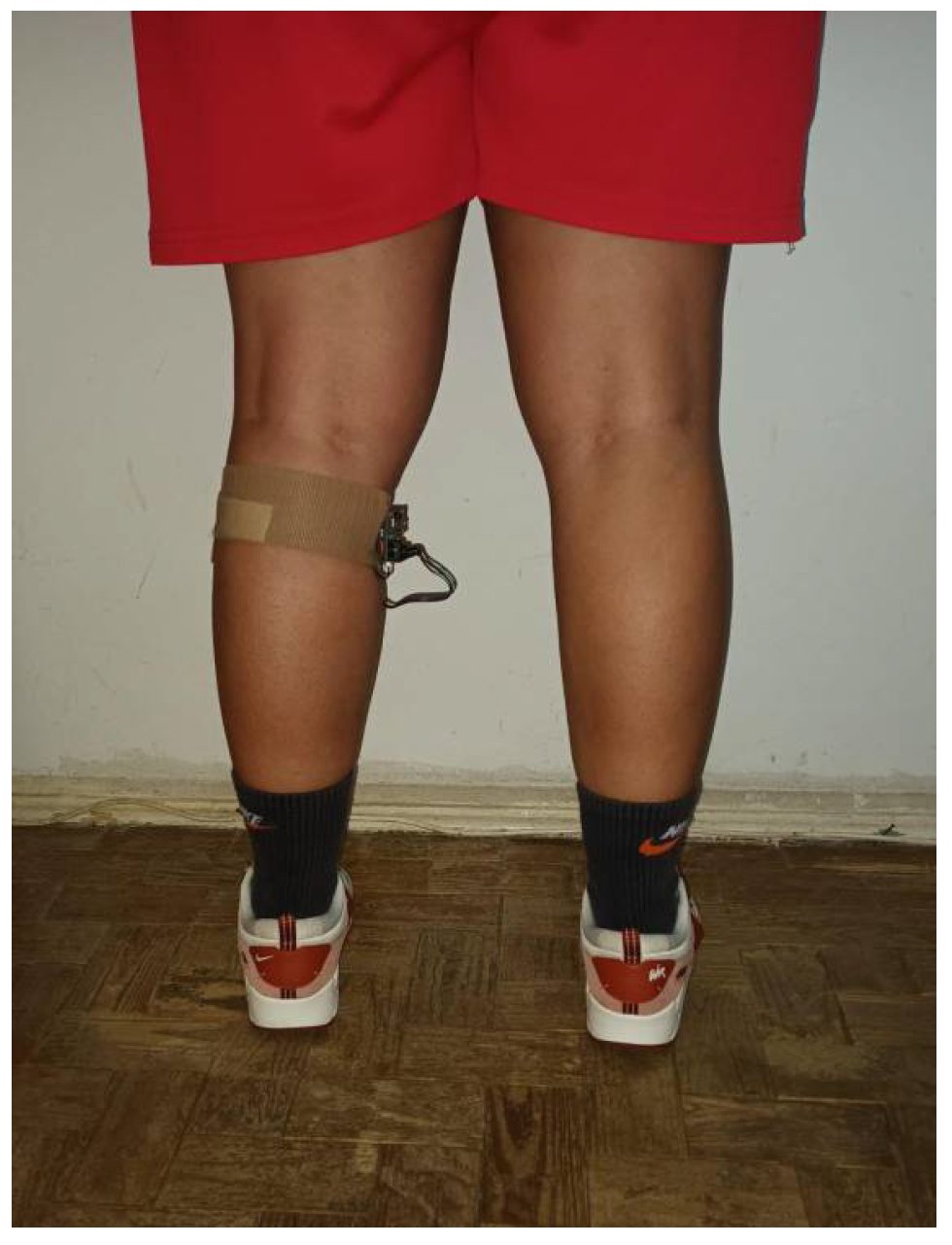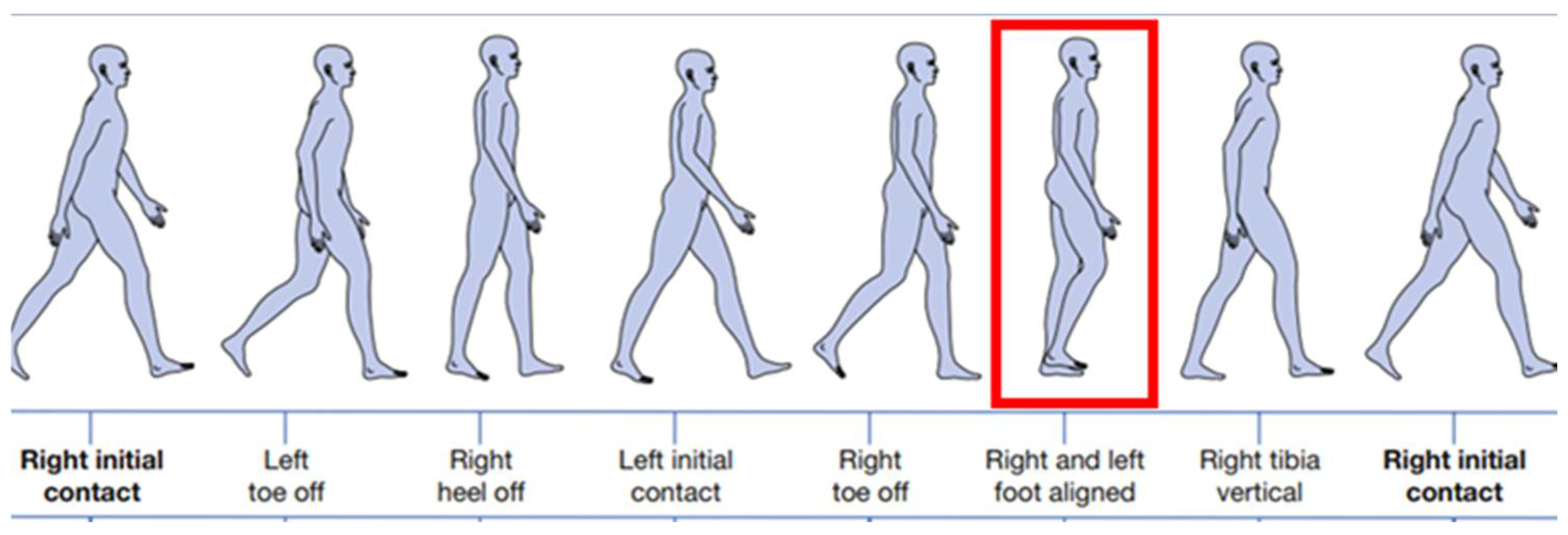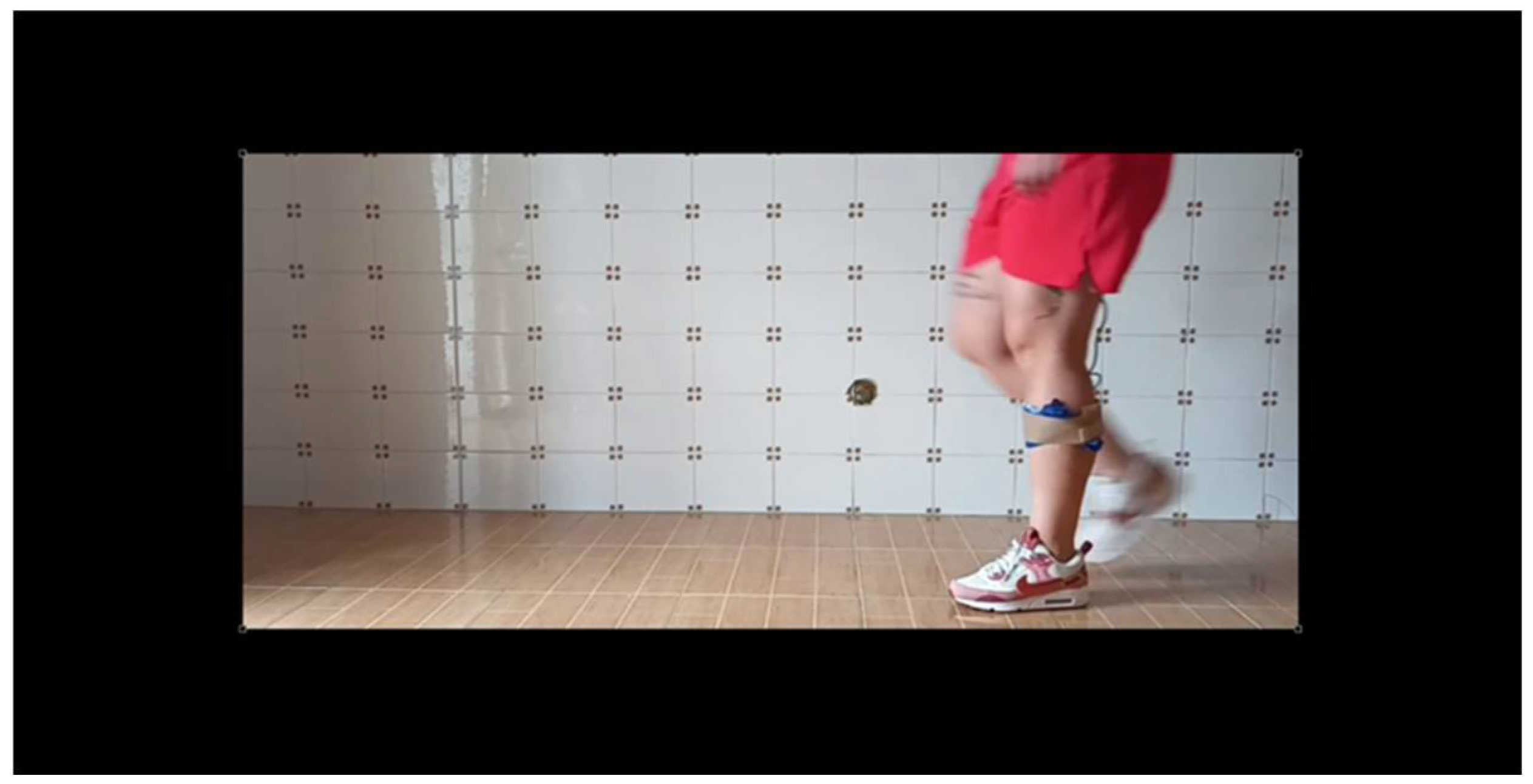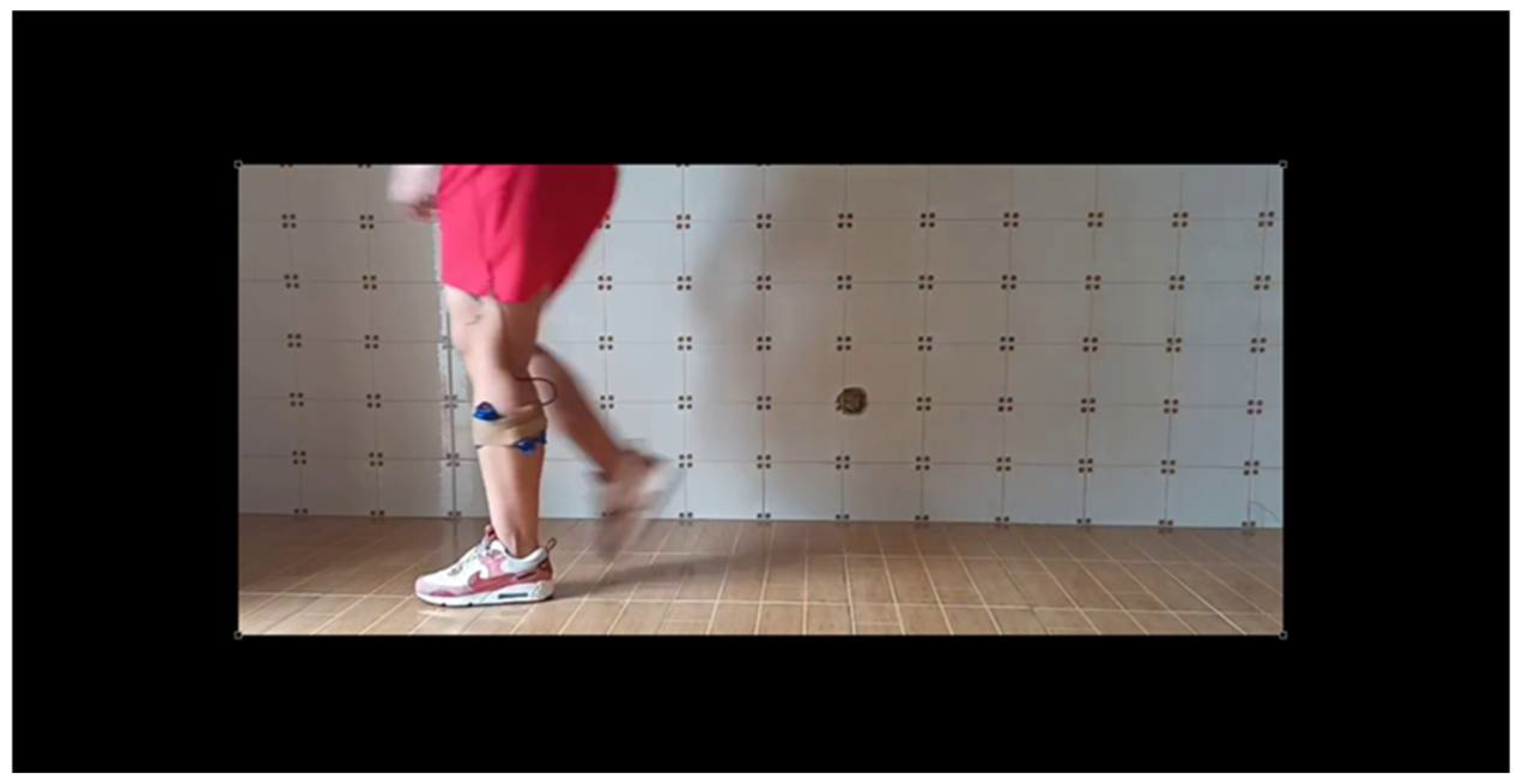1. Introduction
Lower limb amputation has a significant impact on individuals in quality of life, mobility and independence [
1]. Gait recovery is the primary goal of rehabilitation for lower limb amputees (LLA), as locomotion capability is directly associated with quality of life [
2]. In normal gait, there is a sequential and repetitive movement of the lower limbs, ensuring stable, symmetrical locomotion with minimal energy expenditure [
3,
4]. The loss of this capacity has physical, emotional, and social implications. So, humans try to maintain this ability even in the presence of severe impairments, such as amputation [
2], often resulting in altered gait patterns [
4]. In LLA, these changes are influenced by physiological and biomechanical factors that lead to instabilities, asymmetries, and increased energy expenditure [
3]. The deviations are often compensatory gait deviations related either to individual impairments (joint contractures and muscle weakness) or prosthetic factors (misalignment, inappropriate component selection and poorly fitted socket) [
5]. Identifying and correcting such deviations can reduce or prevent long-term health consequences and improve mobility and well-being [
6].
Prescription and functional assessment of prosthetics are frequently based on empirical knowledge, with component selections criteria relying on subjective experience of clinicians, often disregarding individual functional needs [
7]. This inadequacy can result in increased energy expenditure, joint pain, isolation, dependence on others for activities of daily living, and increased healthcare costs [
5]. Thus, healthcare decisions should be evidence based, and prosthetic components should be prescribed in a scientifically grounded and justified manner [
7,
8]. Evidence based decisions require functional assessment tools that provide objective and quantitative data [
5]. Quantitative measurement devices support clinical decisions for rehabilitation interventions based in scientific evidence [
9].
Gait analysis is the primary method for functionally assessing lower limb prostheses and plays a crucial role in rehabilitation [
10]. This set of procedures—used to observe, record, analyse, and interpret movement patterns—aims to obtain information that enhances performance and identifies gait abnormalities [
11]. It enables healthcare professionals to identify gait disorders and supports prosthetic component selection and alignment adjustments. Proper identification of gait anomalies requires a comprehensive understanding of normal gait patterns [
9].
The normal gait pattern results in a gait cycle with well-defined phases. The gait cycle is the interval between two consecutive occurrences of any repetitive gait event, which can be chosen to define the beginning of the cycle [
12]. The gait cycle is divided into two phases, the stance phase and the swing phase, which correspond to the time that the foot is in contact with the ground, and in the air moving forward, respectively. These phases can be further divided into sub-phases: initial contact, loading response, mid-stance, heel-off, and push-off during stance, and acceleration, mid-swing, and deceleration during swing [
13]. Throughout the gait cycle, parameters such as stride length, cadence, gait cycle duration, and gait symmetry can be evaluated [
14]. Gait symmetry is associated with regularity, balance, good coordination, and reduced energy expenditure, making it an indicator of motor control and a criterion for tracking rehabilitation progress [
15,
16], and can be expressed through spatiotemporal ratios such as gait cycle duration [
15]. Gait cycle duration is defined as the time interval between the occurrence of a specific gait phase and its next occurrence, representing the time required to complete one gait cycle [
17]. To calculate this parameter, it is sufficient to identify a single specific event within the gait cycle and measure the time interval between its repetitions [
18].
While some deviations from these parameters can be identified through observation, this qualitative assessment, though useful, depends on the observer’s subjective experience and lacks precision [
10,
19], other deviations must be measured and quantified using gait analysis devices capable of capturing three-dimensional motion and wearable sensors [
20]. Quantitative methods record measurable kinetic, kinematic, and temporal parameters using devices of varying complexity [
9]. These systems primarily rely on sensors, which respond to physical stimuli and transmit a resulting signal in the form of a measurement or control operation [
21]. Advances in these devices have enabled the measurement of body locomotion and quantification of rehabilitation performance [
22], allowing objective gait assessment and providing reliable data to professionals, thereby reducing the margin of error associated with subjective evaluations [
19]. Many of these sensors are integrated into commercial clinical devices, typically expensive and used in laboratory environments without real-time analysis [
23]. Others are integrated into wearable sensors, typically placed on various body segments or joints [
19], with cost, size, and comfort during use being limiting factors [
22].
Given the lack of accessible instruments capable of providing quantitative data for the objective assessment of lower limb amputees—while remaining both physically and economically viable in clinical contexts—a wearable sensor for detecting and analysing gait asymmetries based on Gait Cycle Duration was developed. The aim of this study is to apply the developed wearable sensor in assessing Gait Cycle Duration in transtibial amputees and to analyse gait symmetry through the Symmetry Index (SI) and Symmetry Ratio (SR). Additionally, the study aims to evaluate its potential as a clinical support tool, promoting evidence-based and sustainable rehabilitation adapted to the individual functional needs of users.
2. Related Work
Several solutions for assessing gait symmetry, particularly focusing on gait cycle duration, have been investigated, and quantitative gait analysis has been extensively studied using wearable and non-wearable sensing approaches, aiming to obtain reliable symmetry information outside controlled laboratory environments. Yang et al. developed a measurement device intended for lower limb amputees, consisting of an insole equipped with force-sensitive resistors, designed to be inserted into footwear. The insole is powered by a small battery located at the ankle, providing practical and non-invasive mobility for the user [
23]. Nolan et al. used a similar system with the battery positioned at the waist. This system can measure, in real-time, the ground reaction forces generated by the feet during gait and based on this data determines the duration of the stance and swing phases to assess symmetry between the healthy and amputated limb [
23,
24]. Rathore et al. developed a device combining Force-Sensitive Resistors (FSRs) and potentiometers. The FSRs are placed at specific insole points to analyse plantar pressure distribution during the gait cycle, while the potentiometers measure joint angles at the knee and hip. This device calculates the gait cycle duration of the lower limbs by detecting gait phases corresponding to plantar pressure zones and recording the time interval between consecutive phases [
20].
Other authors have used systems based on Inertial Measurement Units (IMUs). Maqbool et al. employed an IMU comprising a triaxial accelerometer and a triaxial gyroscope, positioned distally on the lower limbs to collect data on limb movement and positioning during gait. These data allowed the identification of different gait phases associated with acceleration and positioning, and subsequently the determination of gait cycle duration as well as stance and swing phase durations from two consecutive steps [
25]. Steinmetzer et al. studied a similar device, equipped with a gyroscope, accelerometer, and magnetometer, which transmits collected data to a smartphone application. The sensors are placed on the distal segments of the lower limbs, and a convolutional neural network programmed to detect gait phases based on the relative positions of the limb segments determines the gait cycle duration [
26].
Recent advances in wearable and non-wearable gait analysis have focused on integrating inertial sensors [
25,
26,
27] and pressure-based indoles [
20,
23,
25]. However, most of these systems require multiple sensors or laboratory environments, limiting portability. In contrast, the proposed LiDAR-based device enables detection of mid-stance with IoT connectivity, offering a low-cost and easily deployable alternative.
As observed in
Table 1, previous systems typically rely on contact-based or multi-sensor setups, whereas the proposed LiDAR-IoT system provides a single point, non-contact solution capable of real-time gait symmetry assessment at low-cost.
5. Discussion
The LiDAR-based gait event detection demonstrated consistent operation across the three cadences tested. The system successfully identified mid-stance instants from the LiDAR sensor and computed Gait Cycle Duration (GCD) values comparable to those obtained from the Kinovea® visual annotation. Although small variations were observed between trials, both approaches captured the same symmetry trend—slightly longer GCD for the left limb—confirming that the sensor accurately detects alternating gait events.
The main sources of error are associated with the dynamic behavior of the sensor during motion, the manual identification of reference events in the video, and the intrinsic resolution of each measurement system. The video reference was recorded at 30 fps, corresponding to a temporal resolution of approximately 33 ms per frame, which may lead to small timing differences when compared with the LiDAR output.
The observed differences between the left and right leg results are minor and arise primarily from measurement-related factors rather than true gait asymmetry. Because the LiDAR device was fixed on the left leg, detection of the contralateral (right) limb occurred while the sensor itself was moving, which can slightly influence the temporal precision of distance readings. Additional sources of variation include the manual identification of mid-stance events in Kinovea® and the 30 fps frame-rate of the video reference (≈33 ms temporal resolution). In contrast, the TFmini-S operated at an effective sampling rate of approximately 3.987 kHz, providing much finer temporal resolution; hence, the discrepancies observed fall within expected experimental variability and measurement precision. Similar inter-limb variations have been reported in optical and inertial gait analysis of healthy subjects, confirming that the present results reflect normal variability rather than systematic bias. Despite these factors, both methods revealed consistent gait-cycle trends across cadences, confirming that the proposed LiDAR-based approach reliably captures the alternating limb pattern and overall symmetry of gait.
The results confirm the feasibility of using a compact photonic sensor to estimate gait parameters in real time, offering a portable and low-cost alternative to camera-based or inertial systems for preliminary gait assessment.
Limitations and Future Work
While the results presented offer promising evidence of the sensor’s ability to detect mid-stance and determine gait cycle duration, some limitations must be acknowledged. The current validation was conducted with a single healthy participant, which restricts the generalizability of the results. The system was tested only on one limb, with gait symmetry inferred indirectly from consecutive detections of the contralateral limb, which may introduce minor asymmetry-related variations. In addition, all experiments were carried out in a controlled indoor environment and compared against a visual reference method (Kinovea®), which is subject to frame-selection subjectivity and limited temporal precision.
The validation performed in this study involved a single healthy participant, and therefore the results must be interpreted strictly as proof-of-concept. Future work will include testing with a larger sample (≥10 participants) to properly assess repeatability, variability and generalization. Future validation should include a larger and more diverse sample, particularly individuals with pathological gait, such as lower limb amputees using prostheses. Testing the device on both limbs alternately is also recommended to assess consistency and identify any side-related variability in detection. Moreover, more robust and accurate reference systems—such as inertial measurement units or pressure platforms—should be employed as gold-standard methods to validate the proposed wearable sensor. These tools enable more precise gait event detection and minimize the influence of subjective interpretation. Extended walking trials with continuous gait cycles and the application of statistical methods will also be necessary to quantify the reliability of the system and support its potential for clinical application.
6. Conclusions
This study presented the development and preliminary evaluation of a wearable sensor system integrating LiDAR and IoT technologies for the assessment of Gait cycle Duration and gait symmetry in lower limb amputees. The device demonstrated the ability to detect mid-stance and calculate GDC across a range of walking speeds.
The comparative analysis with Kinovea® confirmed a reasonable agreement between the wearable system and the visual annotation method, particularly in identifying symmetrical patterns and gait cycle consistency. Although some discrepancies were observed—these can be attributed to the limitation of video-based analysis, sensor displacement during gait, and the reduced number of samples.
The findings support the device’s feasibility as a portable, real-time, gait analysis tool, with potential applications in prosthetic fitting and rehabilitation monitoring. Its low cost, ease of use, and integration with cloud-based platforms position it as a promising solution for more accessible and evidence-based clinical decision-making.
However, further validation is essential Future studies involve a broader and more diverse participant base, employ gold-standard reference systems, and apply statistical methods to evaluate measurement accuracy and repeatability.
